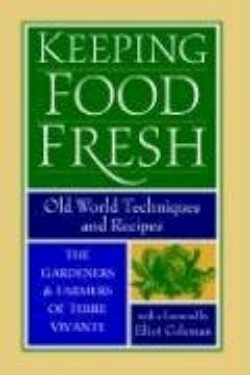Keeping Food Fresh
Old World Techniques & Recipes
In a world where some newspaper editors actually have the gall to feature the newest Twinkie-like processed “foods” on their food pages, this book is a relief. It is infused with the spirit of growing or buying food locally with nutrients intact and then preserving it in ways that enhance and preserve as much flavor and nutrition as possible.
Contrast that, the editors say, to eating a Granny Smith apple sent to your local mega-grocery store from New Zealand, cantaloupes from gas-pressurized warehouses in Mexico or a head of lettuce grown in a “chemical soup” in Florida. The modern-day science of food preservation, they contend, has led to fruits and vegetables “entombed” in frozen or canned coffins on our grocery shelves and freezers, their vitamins and life leached or leaching away. Even those who preserve food at home often resort to costly and energy-consuming canning and freezing, mimicking industrial practices.
This book, instead, focuses on food preservation techniques that are as natural as possible, with little boiling and freezing—time-tested methods still in use in the French countryside where these recipes were gathered.
Long-time farm and garden writer Elliot Coleman (The New Organic Grower), who writes the foreword to the book, calls these techniques “poetic” and the result life-filled foods “that have been celebrated for centuries and are considered gourmet delights today.” They include preserving food in a root cellar (from potatoes and carrots to crushed blueberries), by drying and lactic fermentation (think sauerkraut and pickles, but also Swiss chard ribs, radishes and fruits) and with oil, vinegar, alcohol, sugar and salt. A table in the appendix provides guidelines on which preservation method is best for each kind of food.
Included are 250 recipes from those sent in by readers of the French organic gardening magazine Les Quatre Saisons du Jardinage (Four Season Gardening). The editors explain how food contamination is stopped. Many of the recipes provide estimates on how long the foods will keep in good condition. The recipes, too, contain the often colorful comments of the readers who sent them in, providing sage advice and a sense of a vital human culture.
The magazine is published by Terre Vivante, a twenty-year-old nonprofit association in south-central France that also operates an ecological learning center highlighting energy efficient buildings, organic gardens and water conservation methods for daily life.
Reviewed by
Diane Conners
Disclosure: This article is not an endorsement, but a review. The publisher of this book provided free copies of the book to have their book reviewed by a professional reviewer. No fee was paid by the publisher for this review. Foreword Reviews only recommends books that we love. Foreword Magazine, Inc. is disclosing this in accordance with the Federal Trade Commission’s 16 CFR, Part 255.

